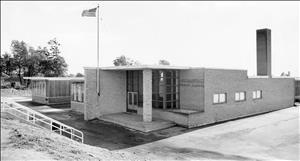This history of Arbor Heights Eementary School is taken from the second edition of Building for Learning: Seattle Public School Histories, which includes histories of every school building used by the district since its formation around 1862. The original essay was written for the 2002 first edition by Nile Thompson and Carolyn J. Marr, and updated for the 2024 edition by HistoryLink contributor Rita Cipalla.
Green Acres
In the early twentieth century, the area south of Fauntleroy in West Seattle was sparsely populated. At first, it was called Green Acres, but later the name was changed to Arbor Heights. The one square mile neighborhood is bounded by SW 98th Street on the north and 30th Avenue SW on the east. Early residents founded their own church (Arbor Heights Church) and community club (Arbor Heights Community Club). In March 1938, the Arbor Heights Improvement Club announced that it was seeking a school for children in the first four grades because neighborhood youngsters were walking as far as a mile down a steep hill to Fauntleroy School.
Several years passed before their dream became a reality. The club managed to buy property in 1940 hoping to build a playground. When a formal request for a school building was made in March 1947, the King County School Board replied that no suitable land was available. The community club responded by selling them the playground property. Anticipating the annexation of this neighborhood into Seattle, the Seattle School District began building a school on the county-owned property in 1948 that consisted of four classrooms with a connecting hallway. The design allowed for adding or detaching classrooms from the central corridor as fluctuations in enrollment occurred. Two other schools of this expandable type, Genesee Hill and Briarcliff, opened the same year.
Hasty Move-In
During the 1948-1949 school year, before the new building opened, four Arbor Heights classes with 126 children grades K-3 were located at Fauntleroy. In April, earthquake damage closed Lafayette. In order to accommodate the Lafayette children at Fauntleroy, the Arbor Heights children were moved into their new building even though it was not yet completed. The grounds were thick with mud and blackboards did not arrive until June. That fall an annex was needed to hold the overflow of younger children. From October 1949 to June 1950, a room was rented in the Arbor Heights Improvement Club (42nd Avenue SW and SW 100th Street) for 23 children in the 1st and 2nd grades. When the teacher requested a bell to call her students to class, she was sent the 64-year-old bell from the old Denny School.
Four classrooms were added in 1950 to resolve overcrowding, employing a style called a “transportable school,” a reusable semi-permanent school structure that could be moved as needed. An addition in 1953 provided an auditorium, lunchroom, gymnasium, covered play court, administrative offices, and a teachers’ room. When the new facilities opened in September 1953, enrollment had reached nearly 500 and the school housed grades K-6.
By 1954, when the Arbor Heights community became part of Seattle, the school was again overcrowded, forcing the 5th and 6th grade classes to operate in double shifts. The city annexed nearby Roxbury Heights on January 1, 1956. As a result, between 225 and 250 elementary school pupils transferred to Arbor Heights and Roxhill from the Highline School District, and nine portables were installed at Arbor Heights to accommodate them. In 1958, an addition of 12 classrooms completed the final phase of the school’s expansion and allowed enrollment to top 800 in the early 1960s.
In 1978-1979, Arbor Heights became a K, 4-6 school and was paired with Van Asselt (K-3). The following year Gatewood (K, 4-6) joined the pair to form a triad aimed at promoting desegregation. This arrangement lasted until 1985-1986, when Arbor Heights and Van Asselt returned to their earlier pairing, with all kindergarten classes housed at Arbor Heights.
A New Arbor Heights
In 2014, the existing 56,000-square-foot building was demolished to prepare for a replacement school, and students were relocated to Boren. The new building includes several sustainable features, including provisions for future ground source heat recovery. Outdoor features were designed to encourage both physical activity and outdoor learning. Arbor Heights opened in September 2016, two years ahead of schedule and under budget. The ribbon-cutting was held September 6, 2016. The 89,000-square-foot school, which accommodates up to 660 students, aims to foster connections between students, community, and the natural environment through a pioneering Environmental Science Technology Engineering Math (E-STEM) program. It houses four small learning communities that include individual classrooms surrounding an open shared learning area and an Idea Lab. The learning communities were designed to promote individual and group teaching and enable experiential hands-on and project-based learning.
In 2017, Arbor Heights, along with two other schools around the country, was awarded a grand prize for outstanding design project from Learning By Design. It was recognized for the openness of its design and its smaller, more individualized learning areas that support the needs of twenty-first century education.
History
Arbor Heights School
Location: 3701 SW 104th Street
Building: 4-room expandable, wood frame and reinforced cement
Architect: George W. Stoddard
Site: 5.0 acres
1948: Named on December 17
1949: Opened as annex to Fauntleroy on April 25
1950: Addition (Stoddard)
1953: Addition (Stoddard); became independent school
1954: Site expanded to 5.65 acres
2014: Arbor Heights School demolished; Students relocated to Boren as interim location
2016: New Arbor Heights Elementary opened in fall (Bassetti Architects); ribbon-cutting ceremony September 6
2017: School awarded grand prize for outstanding design in national Learning by Design contest
Arbor Heights Elementary in 2023
Enrollment: 557
Address: 3701 SW 104th Street
Nickname: Junior Seahawks
Configuration: K-5
Colors: Royal blue, green, white

